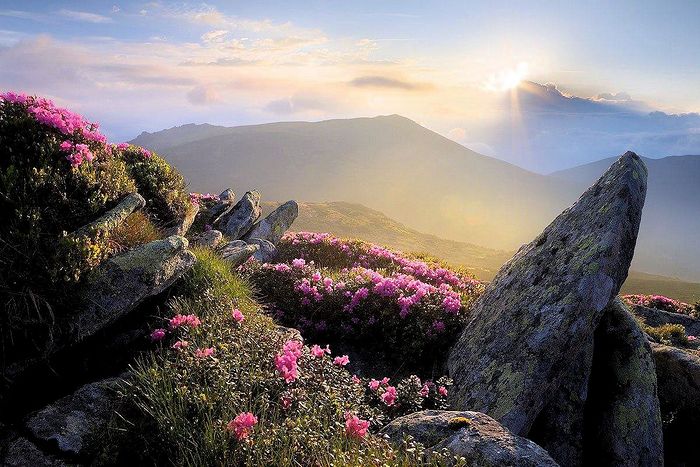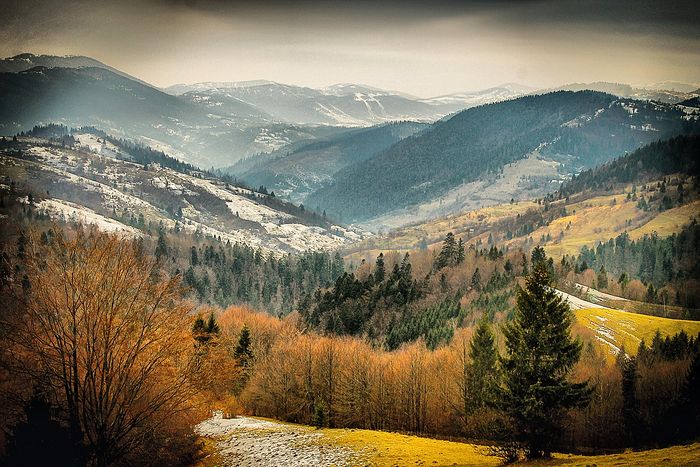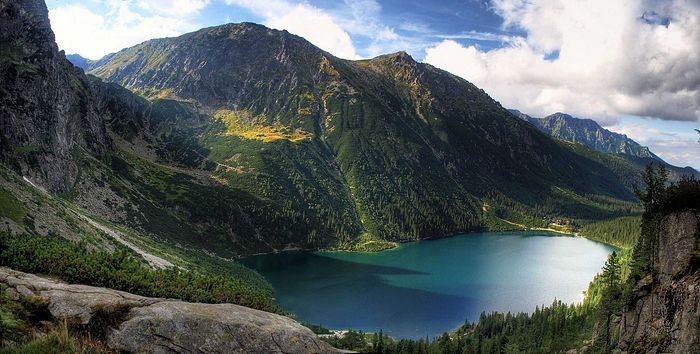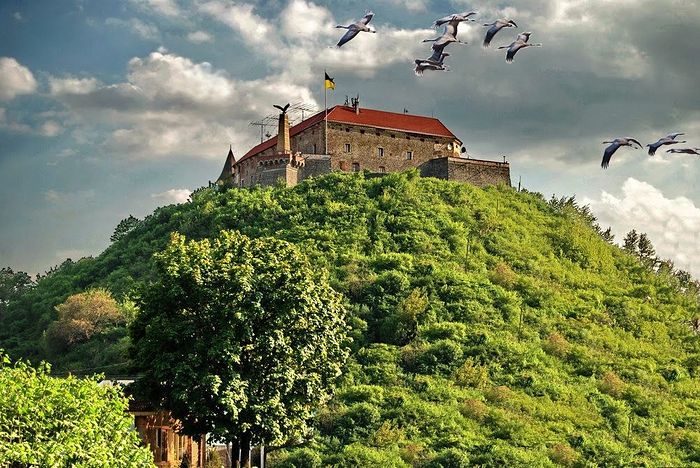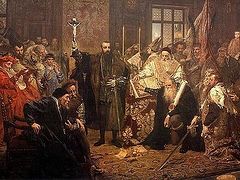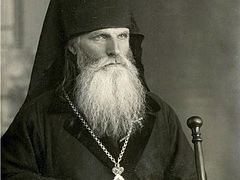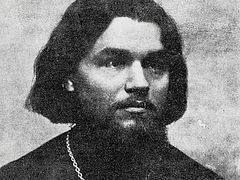Introduction by Matfey Shaheen:
Glory to Jesus Christ! Glory Forever! This is the greeting of Carpatho-Rusyns, and if you use this among your Orthodox friends and family, you help keep alive the legacy of a pious people who suffered much for Christ in the lands of Carpathian Russia, now located on the borderlands of Ukraine, Slovakia, Poland, Romania, and Hungary. Rusyns are an East Slavic nation, a member of the same family as Russians, Ukrainians, and Belarusians, however throughout history, and in Ukraine today, they are often persecuted by Catholic Uniates and various governments trying to suppress their identity and rule them.
This is an article from the acclaimed Mitered Archpriest Dimitry Sydor, the Dean of the Uzhhorod diocese of the Ukrainian Orthodox Church. Father Sydor is considered among the greatest living spiritual leaders of the long suffering Carpatho-Rusyn people, a heroic man who regular gives sermons in the Rusyn language, available on YouTube and the Cathedral Website, and has translated the Gospel of Matthew into Rusyn to educate Rusyn and Ukrainian children on the grammar of this most ancient language. Rusyns have wandered a great deal…but not all those who wander are lost. Despite the majority of countries where Rusyns settled recognizing them as a unique nation with their own language, Ukraine still refuses to recognize their identity, or give them autonomy, considering them only to be ethnic Ukrainian highlanders. Galician Nazi collaborators denied their existence, and after their liberation from the Nazis, Stalin forced them into Soviet Ukraine; since then, the Ukrainian authorities have still not recognized them—because the truth is, Rusyns are very ancient.
Rusyns are so ancient in fact—that their name is the original term for an inhabitant of Ukraine, before the term Ukrainian was forced on the local population by foreign invaders, and carefully fostered by Catholic Uniates helping them to divide and conquer the historical Rus’. To this end, Father Sydor was persecuted by the Ukrainian government before the Maidan, and accused of separatism, even though he is a loyal Christian who merely asks that Rusyns be recognized and denies all accusations. Since we can learn a lot about the broader Ukrainian Church Crisis from this situation, we would like to present articles concerning the history of the Rusyns, as it seems that if we understand these enigmatic and mysterious “People from nowhere”, as famous Rusyn Andy Warhol described his people, we understand a great deal. We can think of no better way to introduce these great people, than this article of Father Dimitry, and we hope it will be the first of several here on Orthochristian.
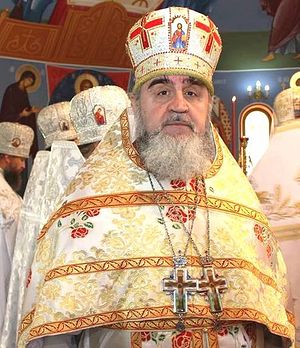 Mitered Archpriest Dimitry Sydor As it is known, God gives unto every nation its mission in this world. One of the most ancient Slavic nations of central Europe—the Rusyns1—were all together not simply by coincidence, preserved by the Lord for a very important mission in the Third Millennium.
Mitered Archpriest Dimitry Sydor As it is known, God gives unto every nation its mission in this world. One of the most ancient Slavic nations of central Europe—the Rusyns1—were all together not simply by coincidence, preserved by the Lord for a very important mission in the Third Millennium.
And so what exactly is the mission the Rusyn nation must fulfill in the beginning of the third millennium, and what exactly is the Rusyn nation itself, which is not known by many, even “diploma bearing” experts?
Why did this ancient Slavic Orthodox nation have to suffer so much grief and oppression from constantly changing groups of nomads, to occupiers and invaders, to the next “liberators”, and then some more “benefactors”? On the basis of the past millennium, we can say with confidence that the Rusyn nation suffered and endured a great test of loyalty to Slavdom and Holy Orthodoxy!
Representing the Tisa-Danube cradle of Slavic nations, Rusyns are decedents of Subcarpathian White Croats (in distinction from the precarpathians-outer Carpathians which the Venerable Nestor the Chronicler mentions in the story of the campaign of Prince Vladimir against the Croats) who by the middle of the seventh century, at the invitation of the Emperor Heraclius had partially moved to the lands of present day Croatian, and partially to the Greek lands near the city of Thessaloniki—to the borders of the Roman Empire.
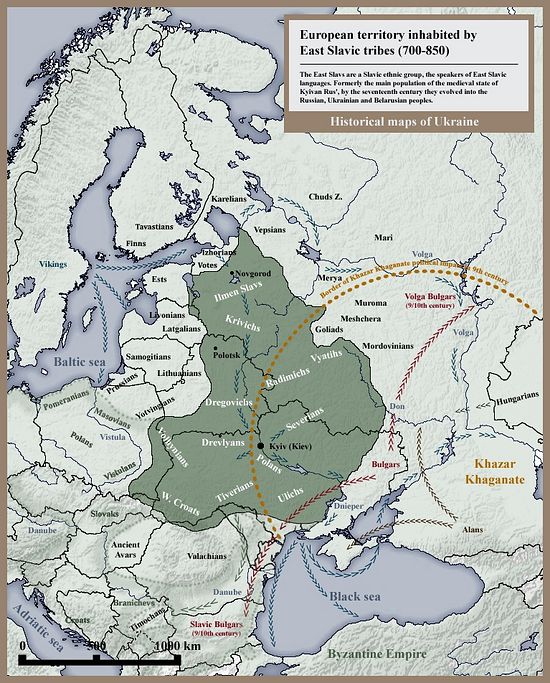 White Croatians (W. Croats on the map) lived near present day Ukrainian Transcarpathia. Subcarpathian Rus’ is located in the Carpathian Mountains, in the border regions of Ukraine, Slovakia, Poland, Hungary, and Romania.
White Croatians (W. Croats on the map) lived near present day Ukrainian Transcarpathia. Subcarpathian Rus’ is located in the Carpathian Mountains, in the border regions of Ukraine, Slovakia, Poland, Hungary, and Romania.
Here, having created Slavic settlements, they survived as such until the first half of the twentieth century.
It’s quite believable that among this group of the White Croats-Proto Rusyns, that Saints Cyril and Methodius were born, raised, and mastered the Slavic language. It is possible that their parents could be from a lineage of White Croats.
This hypothesis about a Proto-Rusyn Slavic language around Thessaloniki is now confirmed by the fact that Rusyns today (and beyond) still possess their original living Rusyn language, which coincides almost 70% with the Old Slavonic Language2.
This attests to the fact that the Proto-Rusyn language, which is similar to the Proto-Bulgarian, could be received as the basis of the Slavic language codified by Equal-to-the-Apostles Cyril and Methodius.
Unlike in modern day Russia and Ukraine, where conversations are being conducted (or to be honest, knives are being sharpened) on the subject of replacing the Church Slavonic Language with the new literary ones, we have hope that in Rusyn Transcarpathia this question won’t even be raised in the next hundred years.
That same portion of White Croats—the Proto-Rusyns, which had remained on the southern slopes of the Carpathian Mountains retained their ancient ethnonym—Rusyns, becoming a part of Great Moravia (and partly in the Ancient Bulgarian Empire) long before the establishment of Kievan Rus’.
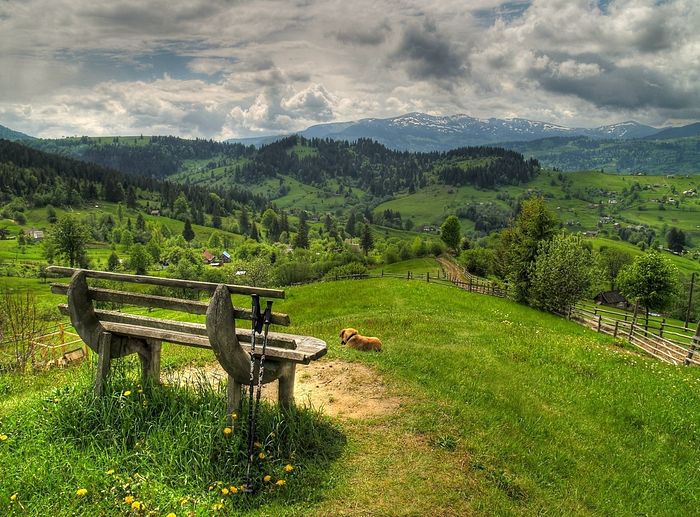 The ridge of the Carpathian mountains near the villadge of Lopushanka, Transcarpathia Viacheslav Yagodzinsky photographers.ua
The ridge of the Carpathian mountains near the villadge of Lopushanka, Transcarpathia Viacheslav Yagodzinsky photographers.ua
The salt road3 at that time ran from Bulgaria to the present day Rusyn city of Solotvyn in Transcarpathia, and therefore it was one of the most convenient routes for Saints Cyril and Methodius, to Moravia (since Transcarpathia was a part of this state).
Vice versa, it was also the shortest path for the students of the Equal-to-the-Apostles Saints when they also had to flee from Moravia to Bulgaria. Few people know, that during those times, it was enough to cross the Tisa river in the area of present day Rusyn Transcarpathian Tyachev-Solotvyna, in order to immediately cross from Moravia into Bulgaria.
Nomadic Magyar tribes, who at the end of the ninth century, although with difficultly, crossed the Carpathian ridge, and found the local population with the name “Rusyns”, left testimony concerning the local inhabitants of Subcarpathia. It was in fact the Rusyns, together with the Bulgarians one hundred years after their baptism, who went to baptize Kievan Rus’. Among them was Moses the Hungarian (a Rusyn from Hungary).
After the arrival of the Magyars,4 by the beginning of the thirteenth century, Rusyns were gradually driven out of their lowlands into the mountains by the newcomers, and became for a long time an unknown nation, pushed further out from the direction of Europe by the Magyar state, and squeezed from the eastern side by the high Carpathian ridge, and almost 150 kilometers of dense forest.
Rusyns lived beneath the Carpathians and for a long time were hardly noticed by historians, but that did not happen by chance. God protected and walled off the ancient Slavic Rusyn people from assimilation with the titular nations, which often became for the Rusyns like elder brothers.
An interesting historical fact: Transcarpathian Rusyns, without leaving their homes, became citizens of almost six states, which in turn tried to pass them off as their original residents.
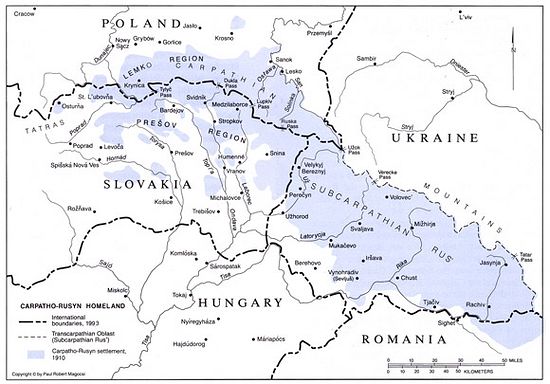 A Map displaying the regions where Rusyns live in blue
A Map displaying the regions where Rusyns live in blue
In 1917, a Bolshevik anti-Orthodox coup took place in Russia. Openly anti-Christian rulers came to power, who were in no hurry to give people land, but began to destroy en mass churches, monasteries, the clergy, and even the language.
At the same time, in the center of Europe, on the ruins of the Austro-Hungarian Empire, small Slavic states appeared, among them a Rusyn state with a curiously strange yet holy name—Subcarpathian Rus’. The Rusyns of the time of the “Spring of Nations” sang the songs of Father Dukhnovich (which later became Rusyn anthems) “Subcarpathian Rusyns awake from your deep slumber”, and “I was, am, and will be a Rusyn, I was born a Rusyn”.
In the twentieth century, the Rusyns solidified their autochthony5 on the southern slopes of the Carpathians (which was recorded by the peace treaty of Saint Germain-en-Laye in 1919), becoming a part of the new European democratic state of Czechoslovakia with the right of autonomy.
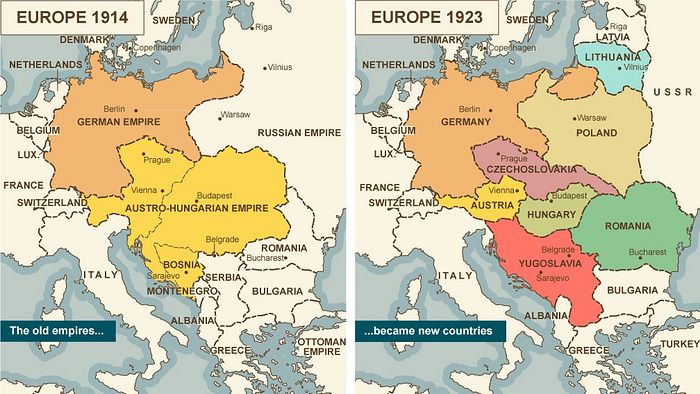 While they didn’t form their own state, Rusyns who were previously in the Austro-Hungarian Empire gained freedoms in Czechoslovakia.
While they didn’t form their own state, Rusyns who were previously in the Austro-Hungarian Empire gained freedoms in Czechoslovakia.
In 1921, the Carpathian Autonomous Orthodox Church of the Serbian Patriarchate was founded in Subcarpathian Rus’. In 1938, Subcarpathian Rus’ received the official status of autonomy as part of the now federated Czechoslovak Republic.
In November 1938 and early 1939, on orders from Berlin, Galician fighters of the “Carpathian Sich”6, as former citizens of Poland, crossed the border in Austrian military uniform and carried out a coup in a smaller part of the territory of Subcarpathian Rus’, illegally renaming it as “Carpathian Ukraine”, with its center in Khust. Most of Subcarpathian Rus’, with its historical capital Uzhhorod, was occupied by Magyar troops. The entire territory of Subcarpathian Rus’ was liberated only in November of 1944 by Soviet troops.
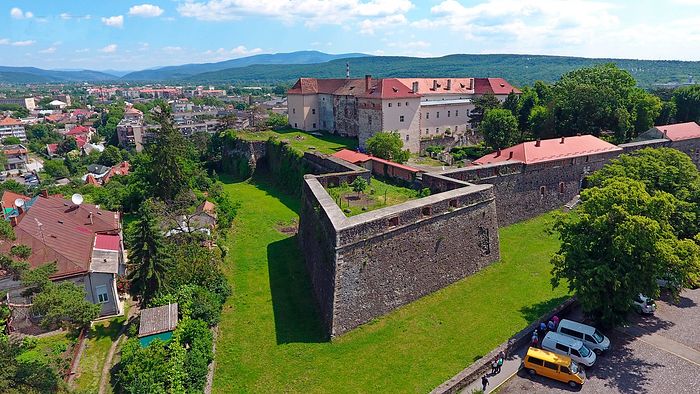 Uzhhorod Castle Source: aboutukraine.info
Uzhhorod Castle Source: aboutukraine.info
After the war, the independent status of Subcarpathian Rus’ within Czechoslovakia was automatically resumed. Stalin however, under the advice of Mekhlis and Khrushchev decided to incorporate Subcarpathian Rus’ into the Soviet Union, as a convenient military staging area and spring broad for expansion into Europe.
Rusyns to this end were not opposed to becoming a part of a large Slavic state, in order to maintain their status of an independent republic with the support of their brothers, the Eastern Slavs.
Plenipotentiary7 delegations from the Rusyns, the ecclesiastical one headed by Archimandrite Alexy (Kabalyuk)—now canonized as a Carpatho-Russian Rusyn Saint—as well as the secular delegation visited Moscow in November of 1944, where they left a memorandum letter to the top leadership of the Soviet Union. It stated that the position of the Rusyns was that, understanding the inevitability of being joined to the Soviet Union, they asked that Subcarpathian Rus’ be joined to the Union as a separate Carpatho-Russian republic. This document is officially published in Ukraine today.
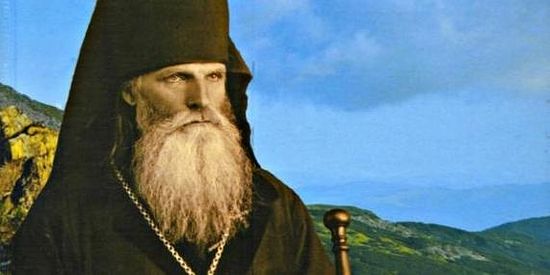 Saint Alexy’s relics lie uncorrupt to this day
Saint Alexy’s relics lie uncorrupt to this day
The position of Mekhlis-Khrushchev won, and most of Subcarpathian Rus’ without the Rusyn city of Syghet which was occupied by the Romanians in 1918 and without part of the land near Debretsen, was annexed to the Soviet Socialist Republic of Ukraine, with the forcible remaining of its inhabitants—who for ages and ages were Rusyns—into Ukrainians.
Subcarpathian Rus’ received from the Bolsheviks the simple name of an ordinary Transcarpathian region of Ukraine. And the Carpatho-Russian Autonomous Orthodox Church of the Serbian Patriarchate became part of the Russian Orthodox Church, not even as an autonomous part, but as a diocese of the Moscow Patriarchate.
In 1991, Transcarpathians, tired of the godless soviet regime, decided on a difficult step, and voted for the independence of Ukraine. At the same time, 78% of them voted for a self-governing territory within the Ukraine. Rusyns again honestly fulfilled their historic mission—to preserve the Eastern Orthodox massif of the Slavs. And it’s true, the collapse of the Soviet Union showed that the three brotherly Slavic peoples, having formed their own separate states, began to fall apart economically.
The canonical Ukrainian Orthodox Church has been the target of attacks by biased Ukrainian pro-Bolshevik minded political actors, who created tiny autocephalous groups for themselves in order to more easily torment the Church of Christ. Rusyns in Transcarpathia bravely defended Holy Orthodoxy, and to this day have not allowed the schismatics into their ancient Rusyn land.
At the Ninth All-Slavic Council in Uzhhorod on May 8-9, 2002, that is, at the beginning of the third millennium, the Rusyns demanded that the Ukrainian authorities restore the historical truth: to return the legitimate ethnic name “Rusyns” and their right to be recognized as an indigenous people on their land.
 The Cathedral of Christ the Savior, Uzhhorod
The Cathedral of Christ the Savior, Uzhhorod
At the same time, we Rusyns fulfill our own God-given mission, namely: We again and again remind the three fraternal Slavic peoples (Russians, Ukrainians, and Belarusians), that the division of a single spiritual and historical Ancient Rus’ into separate parts is abnormal. And it is necessary to do everything possible to preserve the thousand year highly spiritual Orthodox Slavic civilization for humanity as opposed to the civilization of the west (secular, and in the near future, occult and godless).
May our Holy God bless all the Slavic nations, with whom our Rusyn God-fearing and peaceful Orthodox nation belongs.
Now, God has judged [determined the fate—Trans.] of Rusyns to live in Ukraine. Nearly one and a half million Rusyns live in the USA, Canada, Australia, Yugoslavia, Slovakia, Poland, the Czech Republic, Romania, Hungary—and everywhere they are freely recognized as an independent nationality, except in Ukraine, where the Ukrainian government groundlessly and illegally ignores this issue. But here too, the Rusyns fulfill their mission: none of us Rusyns is a separatist or an enemy of Ukraine.
We Rusyns are filled with the desire to be in the Ukraine, together with the Ukrainians and other peoples, as a state-forming nation, with the right to live on an equal footing in this state, do good works, protect the Orthodox Church, and look confidently towards tomorrow. But at the same time, we recall that in the word “Ukrainian” there is, unfortunately, no ancient root of “Rus’”, which means that Ukraine alone cannot be considered the only successor of Kievan Rus’. Moreover, the barbaric hatred of some Ukrainian officials toward the very word Rusyn is incomprehensible.
Or perhaps, the highest Ukrainian triumphalist set out to eradicate not only the name of Rusyns, but also the very mention of Kievan Rus’, while also beating the heads of its citizens about the “super ancient Ukrainian nation”, and provocatively calling the lands of Slovakia, Poland, and Yugoslavia (the Bačka region—Ruski Krstur) ethnic Ukrainian lands, as they are inhabited by ethnic Rusyns, whom Kiev wants to recognize only as ancient Ukrainians.
I will say that the mission of the Rusyns of Transcarpathia is not yet complete, I think it will be continued further, in order to cool the hot heads of the Ukrainian ethno-fanatics of the third millennium.
In the spiritual sense, we Rusyns want to live, work, and wait for the Second Coming of Christ with the Orthodox Faith, Love, and Hope. At the same time, we know that the Lord will address us Rusyns at the Righteous Judgment in our Rusyn mother language. And woe to us if we Rusyns don’t understand the Lord, and don’t recognize our Rusyn language!
For our honorably fulfilled mission, we hope to receive as reward from God—the salvation of the soul and the Kingdom of Heaven.

